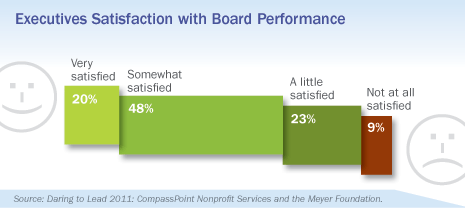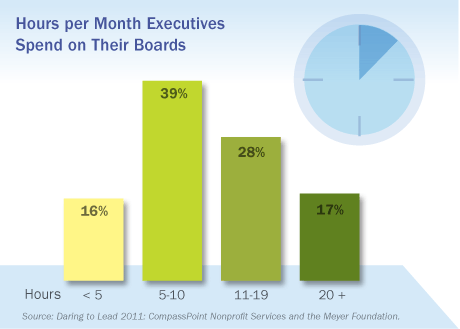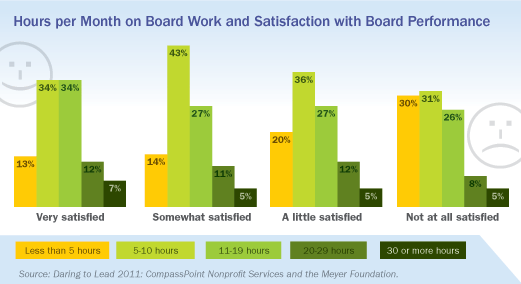Boards
Jun 13, 2011 by Marla Cornelius in Boards
These are the key findings from Daring to Lead 2011 related to boards of directors. For more information, download The Board Paradox: Daring to Lead Brief 3.
Board Performance—More than two-thirds (68%) of executives were somewhat satisfied with their boards’ performance, and of those nearly 20% were very satisfied. The remaining respondents–nearly a third–were either very unsatisfied or only a little satisfied. Among all respondents, the largest number (48%) were only somewhat satisfied with board performance.
Thirty-eight percent (38%) of executives were very confident that their own efforts could influence their boards’ performance. Just 6% reported that they had no confidence in their ability to do so.
Board Chair Relationship—Most respondents felt positive about their partnership with their board chair. A majority (52%) described the relationship as functional, and a large number (38%) described the relationship as exceptional. Only a small minority (9%) reported a dysfunctional relationship.
Performance Evaluation—Forty-five percent (45%) of executives did not have a performance evaluation last year. Among the majority of executives who did have a review within the past year, just a third (32%) said it was either somewhat useful or very useful, with the remaining two thirds reporting that it was only a little useful (53%) or not useful at all (15%).
Board Support—Nearly three-quarters (73%) of executives reported strong support from board members in the area of financial oversight. However, nearly half (44%) have not achieved 100% giving.
Executives reported lower participation rates than in other areas of board responsibility, with the exception of board members making a personal contribution (71%). Fewer than half of respondents reported strong board member participation in donor identification and prospecting (48%), asking for gifts (42%), and donor cultivation (41%).
Time Spent on Board Work— The majority of respondents (56%) reported spending ten hours or less per month on board-related activities which translates to just six percent of a full-time executive director’s time. Only about 17% of respondents reported spending 20% or more of their time on the board.
Among executive directors who spend ten hours or less per month on board-related matters, only 17% said they were very satisfied with the board’s performance. Of those who spent more than ten hours per month working with the board, 23%—nearly a quarter—were very satisfied with board performance. More than a third of respondents (36%) said they needed to spend more time on the board.
Executives who spend more than 10 hours per month working with the board were more likely to have had a performance evaluation within the past 12 months, and were much more likely to report that the evaluation was very useful.

Policy & Advocacy — Eighty-five (85%) of executives spend some time on policy and advocacy related activities. Of those, 47% believe they do not spend enough time in this area. Regardless of the mission type of an organization, if it receives a majority of its revenue from government contracts, the executive was significantly more likely to be engaged in policy activities. Four percent (4%) of executives leading majority government funded organizations said they did not need to spend time on policy and advocacy, compared with 18% leading non-majority government funded organizations.
Executives’ on Boards—Forty-nine percent (49%) of executives were currently serving on a board of directors for an organization other than their own.
Note: Other studies have found that executives who spend 20% of their time on board-related activity have high rates of satisfaction with board performance.


Valyrie Laedlein
29. Jun, 2011
This is a wonderful set of data to work with – which, of course, begs only more questions about what’s really critical to maximizing a board’s effectiveness.
Among New York City respondents, over 3/4 of Executives were “somewhat” or “very” confident in their ability to influence their board’s performance. Your table that relates time spent on board work to executives’ satisfaction with board performance is telling. For those executives seeking to exercise that influence on their boards, there is an important message about the investment of time required to do so.
The conundrum, of course – especially for small organizations with limited middle management (or for those whose middle management has dwindled in the face of budget cuts) – is that executives’ available time to DO board work is in scarce supply. Hence their boards languish.
Board members – like others – are swayed by data. The DTL study gives executives some powerful information about where boards do and do not seem to step up. It can be used to surface questions for board members to grapple with about their areas of competence, how they might best contribute to their organizations, and how executives perceive boards. This study can open the door to good dialogue between executives & their boards.
Valyrie Laedlein, Co-Director
Community Resource Exchange
Dorian Luey
29. Jul, 2011
Thank you, Marla, Rick, and Jeanne for this outstanding report. Most impressive is its circumspect approach and succinct calls to action. I anticipate that the next brief (or future study) will focus on what motivates board members to join organizations with the similar lens you apply to Ready to Lead and Daring to Lead. That is, do board members understand the full undertaking of achieving social change – utilizing these organizations as a vehicle – and how can organizations systematize the training of board members to meet this goal?
It’s relieving to know from your data that 47% of executives currently serve on a board, but one can assume that many boards are largely comprised of individuals who don’t do non-profit work for a living. Thus, I would like to see CompassPoint probe further using various board member profiles or scenarios where personal and professional motivations are explored.
Organizations strive to recruit board members who are both committed to their social change agenda and well-resourced, but more often than not they come with one or the other. Most board training opportunities are focused on fundraising and governance but not explicitly on their role in affecting social change to the communities their organization serves. I believe this is on the agenda for our “next generation” board members!
Thank you again for doing this study, and for soliciting feedback so elegantly with this dedicated website!
Dorian Luey, Operations Director
Richmond District Neighborhood Center
Marla Cornelius
05. Aug, 2011
Thanks for this post Dorian. We just released the third and final brief of the Daring to Lead series, The Board Paradox.
This brief includes findings about how much time executives spend working with and supporting their boards, satisfaction rates with board performance, and insight into how executives can work more effectively with their board members.
Though we begin to explore these issues here, you’re right that there is much more to understand when it comes to boards, their motivations for service, and the impact the ultimately make on organizations and communities.
I think your call for a new agenda for next generation board members hits the mark. We’d love to hear from you as well as others about ideas you have for such an agenda.
Marla Cornelius
CompassPoint